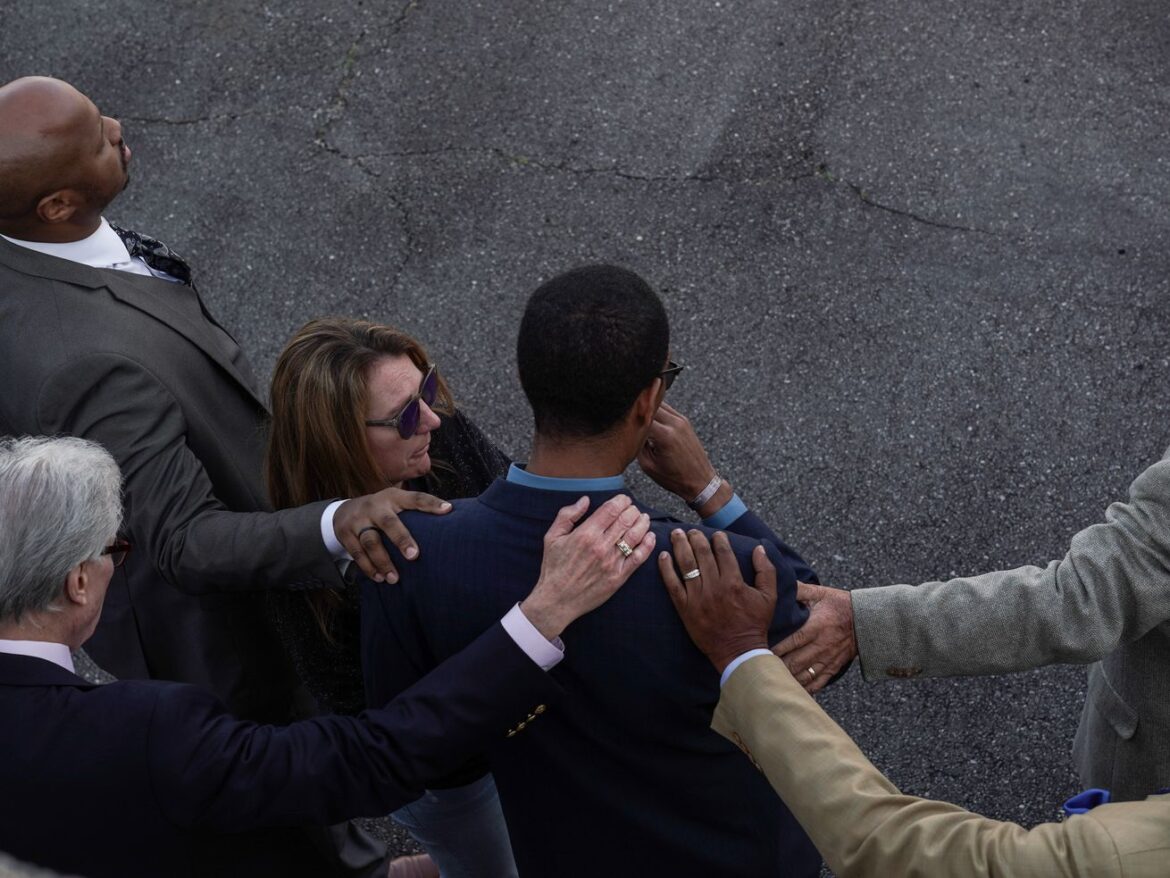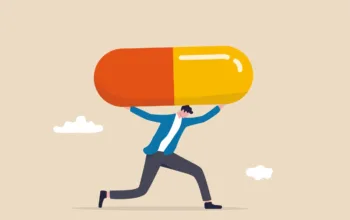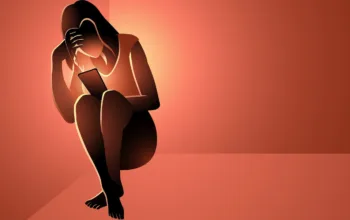The Alabama mass shooting this week highlights how helpless we can feel in the face of gun violence. Here’s what experts and advocates say can make a difference.
When most of us think of April, we associate it with spring. But for researchers who study extremism and violence, the month has other, darker connotations: “We sometimes refer to April as the beginning of the killing season,” one told the Washington Post in 2016.
This year appears no different. Four people were killed and 28 injured this weekend when a shooter opened fire at a Sweet 16 birthday party in Dadeville, Alabama. According to the Gun Violence Archive, there have been more mass shootings than days so far this year: The Dadeville incident was the 159th mass shooting of 2023, following recent shootings in Louisville, Kentucky, which killed seven people in total, and at a school in Nashville, Tennessee, which killed six people — three of them children.
“What has our nation come to when children cannot attend a birthday party without fear?” President Biden said in a statement responding to the Alabama killings.
It has come to this: Gun violence is now the leading cause of death among US kids and teens. Amid an overall increase in gun deaths over the last two decades, the number of children killed by guns soared between 2019 and 2021, increasing a shocking 50 percent.
Details about the victims of this weekend’s shooting are still trickling out, and very little has been revealed about the shooter. One of the teenagers who died, Philstavious “Phil” Dowdell, the brother of the birthday girl, was a football player who had just committed to a college when his life was cut short. Another, KeKe Nicole Smith, was a volleyball player, remembered by a coach as “full of life.”
KeKe, Phil, and the other victims in Dadeville shouldn’t have died like this. And we shouldn’t have to live like this.
Every year, communities across the United States experience preventable shootings because the country has too many guns and not enough regulation on their access. Guns kill more than 40,000 Americans a year, in an epidemic that disproportionately affects Black and brown people.
Mass shootings are in the news so often that at this point the reactions are familiar: consternation, anger, acquiescence. The more constant, quotidian incidents of gun violence, which kill tens of thousands of people each year, rarely receive the urgency and attention they deserve from policymakers and the media. The fact that the United States stands alone among high-income countries for having the most gun-related deaths seems to do little to puncture the collective sense of hopelessness that sets in after another shooting.
When gun violence happens, trauma often ripples outward, from victims and survivors and loved ones to society as a whole. It extracts a psychological toll on all of us. We now live in what Peter Sagal, author and NPR host, calls “a kind of permanent Sarajevo” — a reference to the brutal, years-long siege of the European capital during the Bosnian war — where “whenever we go outside, to work or school, to walk our dogs, to attend our parades, we know without saying and accept without protest that gunshots might ring out and take our lives or the lives of those we love.” In the 1990s, when school shootings beset small towns across the US, people commonly asked, “How could it happen here?” Thirty years later, it would be difficult to find anyone so naive. We all know: It could happen anywhere.
Major reform, initiated on a federal level and aimed at reducing the overall number of dangerous weapons in circulation, is desperately needed to save lives. It’s a goal that activists have been pushing for unsuccessfully for years, due to Republican-led opposition.
There are a lot of reasons why progress on reducing gun violence feels like a grind. While Democratic-led states are passing legislation restricting access to large-capacity magazines and limiting concealed carry, Republican-led states are moving in the opposite direction. The National Rifle Association’s lawsuits and internal conflicts don’t mean that the pro-gun movement is going away. Most troublingly, a recent Supreme Court ruling in New York State Rifle & Pistol Association v. Bruen held that Americans had a right to carry weapons in public for self-defense and imposed strict new standards for judging whether gun laws were constitutional, raising the possibility that many state efforts to regulate guns could be overruled by the courts. Already, a federal appeals court struck down a national law barring individuals under restraining orders for domestic violence from possessing guns. The Bruen decision, says Kristin Goss, a professor at Duke University who has closely studied the gun violence reform movement, “could really destabilize a lot of the state laws.”
Still, to believe that nothing can be done to reduce gun violence requires overlooking a lot of what has changed in the fight over gun reform, especially over the last 10 years. It ignores a major shift in American political culture, in the emergence of a well-funded and well-organized movement for gun violence prevention, led by survivors, parents, students, and community leaders. It sidesteps the number of politicians who now openly align with the cause. It ignores the way the gun lobby has been weakened by mismanagement and legal trouble, and the fact that Congress finally did pass legislation to address gun violence in 2022 — the first time it has taken major action to address guns in nearly 30 years. The legislation provided millions in funding for violence intervention programs, and while some advocates and experts think it could have been much more aggressive, most acknowledged that it included important new regulations for both dealers and buyers.
The notion that nothing ever changes also ignores the number of meaningful state measures that advocates have successfully pushed into law. As of 2021, according to Everytown for Gun Safety, 21 states and Washington, DC, passed legislation requiring background checks for all prospective handgun sales; 19 states and DC passed “extreme risk” laws that allow judges to order someone’s guns confiscated if they appear to be a serious risk to themselves or others; and nearly 30 states passed laws aimed at keeping guns out of the hands of domestic abusers.
Activists fighting to end gun violence say the problem is too big, and too serious, to give up on — no matter how intractable the problem may seem. Here’s what experts and advocates say is making a difference.
Political power
Linda Cavazos’s younger brother, Louie Pacheco, died by gun suicide in 1980. Cavazos, a teacher at the time, remembers colleagues at the school where she worked assuring her that she didn’t need to tell anyone about what happened to Louie, even though she wanted to. “It was the third rail nobody wanted to talk about,” she said. The gun violence prevention movement was a fraction of the size it is now. Losing her brother inspired Cavazos to shift careers and become a therapist who worked with suicide and gun violence survivors. In 2018 she ran for, and won, a position as district trustee for the Clark County School Board in Nevada, the fifth-largest school district in the country. In her position, she worked with advocates to help pass a resolution requiring safe firearm storage information in the registration materials each parent in the school district must sign off on before their kids can begin school.
Cavazos isn’t alone. In 2022, nearly 300 Moms Demand Action volunteers or supporters ran for state, federal, and local office, and almost 140 won their races, putting them in a position to push legislation targeted at reducing gun violence. Perhaps the most prominent activist-turned-lawmaker, Rep. Lucy McBath (D-GA), whose son Jordan Davis was killed by a gunman in 2012, has made honoring her son’s legacy and pushing for reform the cornerstone of her legislative career.
“There’s been quite a bit of movement on the state level, and on organizing size, the capacity is vastly, vastly greater,” Goss says. That increased capacity is reflected in the amount of money that national gun reform groups receive. According to an analysis by the Chronicle of Philanthropy, donations to national gun reform groups in 2011, the year before the shooting at Newtown Elementary School in Sandy Hook, Connecticut, were roughly $13-$14 million. By 2019, national groups — which now include Everytown for Gun Safety (which includes Moms Demand Action), Sandy Hook Promise, and more — raised upward of $168 million, according to Philanthropy’s analysis. More money in the movement means more capacity to support the voices of survivors who these groups say are the most effective advocates for change, both within the movement and in political office.
Cultural change
When the problem is as maddeningly obvious as “too many guns” and reducing the sheer number of guns overnight is virtually impossible, it’s easy to feel as though anything less is meaningless. It’s not.
Experts have been identifying other ways of changing the norms around gun culture, taking cues from public health campaigns that have been successful in the past, like the effort to reduce teen smoking. One of those organizations, Project Unloaded, is working to change the belief — contradicted by the data but held by many Americans — that owning a gun makes them safer, by working with teen activists to help spread awareness of the ways gun ownership increases the risk of injury or death. Nina Vinik, executive director and founder of Project Unloaded, thinks approaching young people with the data is a key component of fomenting generational cultural change. “When we reach teens with a simple, fact-based message that’s divorced from polarized rhetoric around this issue, we can change their views,” she says. “They shift away from a belief that guns will make them safer and move away from interest in future gun ownership.”
Others are working to change the conversation among parents by normalizing conversations about safe storage of guns. More than 4 million children in the United States live in a home with an unlocked, loaded firearm, according to one 2015 survey. Convincing parents to lock them up can prevent accidental deaths. “We can prevent so much gun violence by addressing this one thing,” says Johanna Thomas, who focuses her efforts on educating parents through the Be SMART program, which encourages parents to model safe gun storage for their kids. “It’s an easy thing we can do to ensure the safety of our children and people can wrap their brains around it,” she says.
Violence intervention programs
Activists are also optimistic about an area of gun violence prevention where federal and state lawmakers have recently directed an influx of cash: violence intervention programs, which are community-based approaches targeting the people most at risk of becoming victims of gun violence, trying to prevent violence before it happens. The federal government has recently invested millions of dollars into funding community-based violence prevention efforts, via the Biden administration’s American Rescue Plan, the Bipartisan Safer Communities Act, and other programs. The boost in funding gives these community-based efforts — which have shown promise and effective results in some communities — an opportunity to work.
State governments are investing in the effort, too. During the pandemic, activist Alex Navarro, an advocate for violence interruption groups with Moms Demand, led an effort to encourage California lawmakers to invest in local programs. She had a large banner made that toured the state, gathering signatures from voters and lawmakers in support of the increased funding. Activists were asking for $114 million. In the end, Gov. Gavin Newsom (D) announced a $200 million investment for the community-based groups. The effort, Navarro says, was “a testament to us coming together and advocating for this, especially in places where gun violence isn’t as high, with the understanding that whatever happens in one community causes a ripple effect and reaches us all.”
It will likely take time to see the results of increased investment in these programs. But Greg Jackson, a gun violence survivor who is the executive director of the Community Justice Action Fund, which focuses on the impact of gun violence on Black and brown communities, says that they’re meaningful enough that this could be a pivotal moment.
“A lot of the resources we need are just starting to be implemented, and a lot of the programs and strategies we need to address this crisis are in the works now,” Jackson says. “It still takes time for those dollars to get to work and save lives.”
It’s difficult to know, exactly, how many lives could be saved with these efforts. But they are areas where survivors and their loved ones are putting their attention and energy because they believe that it could save others from becoming victims. We owe it to them to listen.



